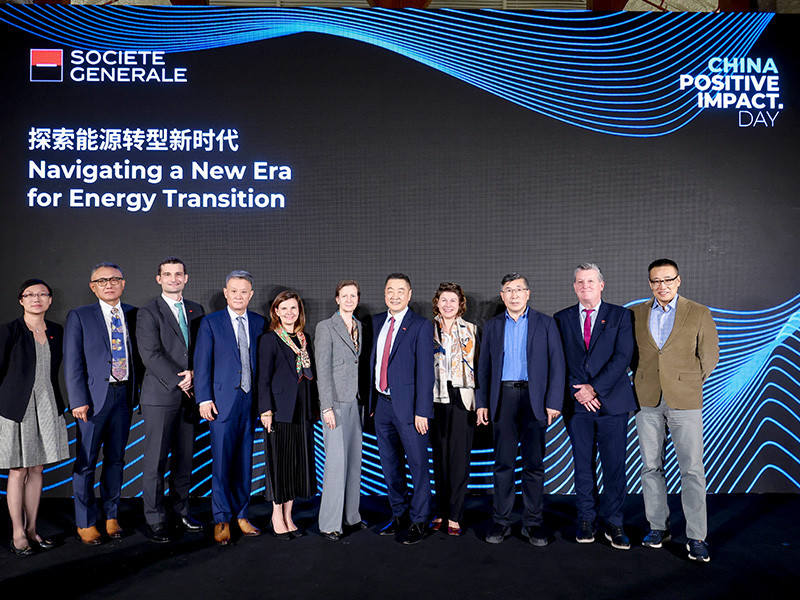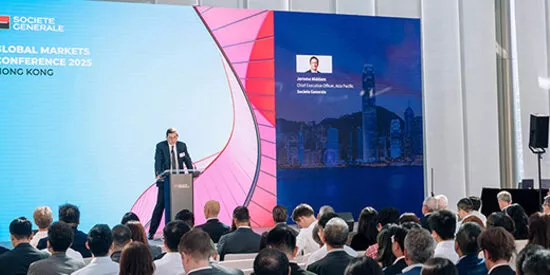
Sino-European partnerships in focus at Positive Impact Day in China
The China edition of Societe Generale’s Positive Impact Day explored the role of capital, technology and international collaboration in the sustainable transition, with a particular focus on opportunities along the China-Europe corridor.

The China edition of Societe Generale’s Positive Impact Day explored the role of capital, technology and international collaboration in the sustainable transition, with a particular focus on opportunities along the China-Europe corridor.
Business leaders, strategists, and industry experts gathered in Shanghai in late October to discuss the link between decarbonisation and competitiveness in China and beyond.
Opening the forum, Dr. Xin He, Chief Country Officer for China and CEO of Societe Generale China, highlighted the continued importance of sustainability in policy frameworks in both China and the European Union.
“Ten years on from the Paris Agreement, China and Europe have declared they will deepen cooperation on energy transition and green technology, and safeguard multilateral climate governance driving the global shift to a green, low-carbon economy,” said Dr. He.

Europe-China: Complementary strengths, competitive goals
The conference highlighted a number of shared policy objectives between Europe and China.
Europe has made low-carbon development a centrepiece of efforts to boost its competitiveness, following the recommendations of former European Central Bank president Mario Draghi in a landmark report in 2024. Removing hurdles to growth — especially around energy costs, regulatory complexity and uneven access to finance — is seen as essential to Europe’s economic outlook.
China, meanwhile, is accelerating its climate transition with new targets announced in September, including a goal to increase the share of non-fossil fuels in total energy consumption to over 30% by 2035 and increase wind and solar power capacity by more than six times 2020 levels by 2035.
Speakers at the event noted that Europe and China exhibit complementary strengths across the clean-tech stack. Both have strengths in wind, hydrogen, and green transport, while Europe has expertise in biofuels and advanced battery ecosystems, and China’s industrial champions lead in solar, battery and several complex manufacturing technologies.
This provides fertile ground for co-investment opportunities and clean technology partnerships that are aligned with policy initiatives at each end of the EU-China corridor.
Technologies of tomorrow for a decarbonising world
Other sessions focused on the green value chain — including energy storage, grids and the latest developments in photovoltaic (PV) and wind technologies. Speakers discussed how geopolitics and policy — tariffs, localisation, and evolving green taxonomies — are reshaping supply chains, even as falling equipment costs accelerate adoption across emerging markets.
Demand for energy storage solutions is accelerating at an exponential pace across emerging and developed markets. As more solar and wind power comes online, batteries and energy storage systems are becoming all the more important in allowing grids to make full use of renewable energy and deliver electricity to their customers around the clock.
Meanwhile, rapid AI adoption and surging investment in data centres is also leading to faster deployment of storage and grid upgrades — particularly in markets with constrained transmission and reliability. The AI-driven data-centre buildout is also leading to heightened demand for natural gas and metals, notably copper for electrification and grid expansion.
While grid expansion is already a core component of the energy transition, the additional power demand from data centres introduces an incremental challenge to achieving a decarbonised economy through increased electrification.
In China, the electrification of transport and industrial processes requires investments to match variable generation with robust storage and smart grids. Speakers also highlighted the need for transmission corridors to move power from resource-rich northwest provinces to coastal load centres. In remote and industrial sites, microgrids will be needed to provide electricity where the main grid cannot reach.
Several speakers pointed to Southeast Asia and parts of Africa as compelling growth markets for China’s clean energy sector, noting that distributed generation and battery storage can allow less-developed markets to leapfrog legacy grid constraints.
Innovative financial infrastructure could also help scale capital flows to sustainable activities. The audience heard how digital currencies and regulated stablecoins could streamline cross-border payments, help clients meet collateral needs in different markets, and even ease settlement for green assets — potentially accelerating trade and project finance through faster international payments.
China’s green champions go global
Investors at the event observed that while China’s renewable manufacturing scale is a competitive advantage, overcapacity and price wars have put pressure on margins.
As a result, many Chinese low-carbon businesses are looking overseas. Companies that master the complexities of globalisation will be best positioned to capture the next wave of growth — localising production where necessary, meeting diverse regulatory regimes, and building brands and service capabilities abroad.
Speakers emphasised that China’s new-energy value chains are comprehensive and efficient, but sustained success demands international operations. With policy changes and global trading relationships still in flux, this will require effective governance and potentially local partners who can navigate import and export restrictions.
Societe Generale is helping clients fulfil their sustainable growth objectives in this complex environment with a range of financing solutions — from green and sustainability-linked financing to transition finance for hard-to-abate sectors – as well as risk-mitigation and advisory solutions.
The Bank has deep roots in China. With a presence on the ground since 1981, Societe Generale has a track record of more than four decades of partnership and investment in the country.
Societe Generale’s China branch is one of the first foreign banks to be approved by the People's Bank of China for a carbon-reduction facility, designed to encourage financial institutions to support green and sustainable development.
Having set a new target of contributing EUR500 billion to sustainable finance between 2024 and 2030, Societe Generale’s China Positive Impact Day signals its continued commitment to helping clients capture opportunities in China and beyond.
Said Dr. He: “Let's take this forum as a starting point as we work together to leverage the power of finance and industry, empower the future with positive influence, and write a new chapter of green and sustainable development.”

Sino-European partnerships in focus at Positive Impact Day in China
The China edition of Societe Generale’s Positive Impact Day explored the role of capital, technology and international...

Societe Generale awarded at the IJGlobal ESG Awards 2025
Societe Generale wins “ESG Global Financial Adviser of the Year" and “ESG APAC Lender of the Year” at the IJGlobal ESG...

Smart Meters: towards optimised energy management
Globally, the need to modernise water and energy distribution networks is becoming increasingly urgent, in order to...

Shifting Perspectives: Outlook for Asian Investors In A Rapidly Evolving Landscape
In a world where markets are fragmenting and innovation is accelerating, Societe Generale's Global Markets Conference in...

